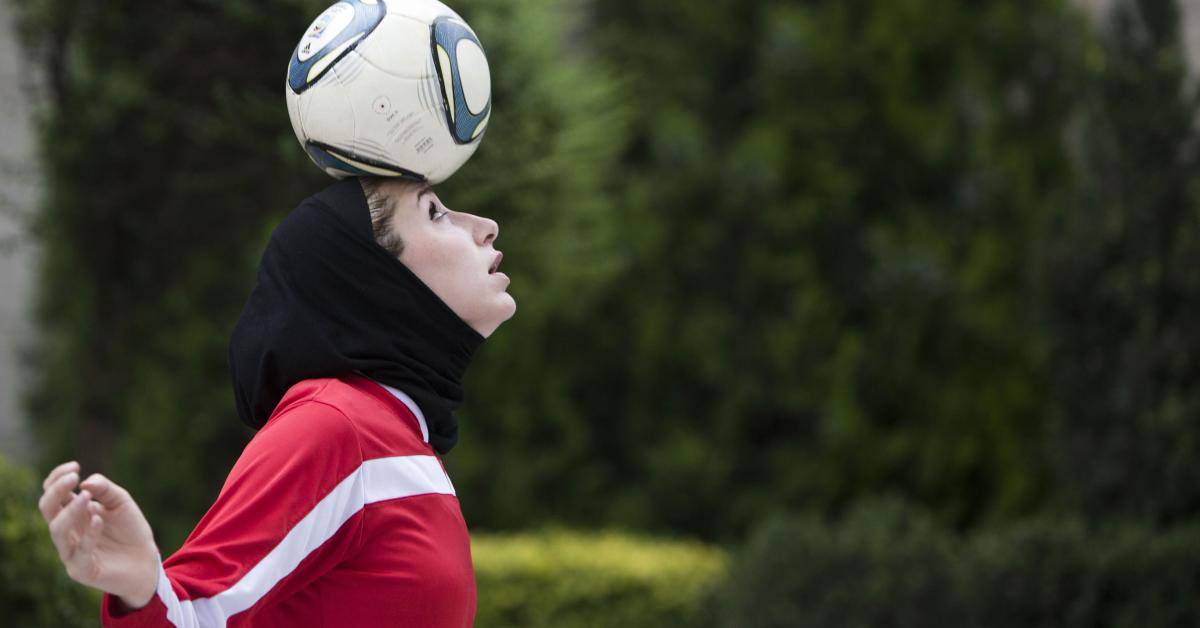Women, and women’s sports, still face stiff winds of resistance in the Islamic Republic of Iran. Hard-liners supported by the highest echelons of government oppose women even watching the country’s most popular sport, much less playing it in public.
But quietly, there is something of a women’s soccer revolution going on here. And one of its leaders, of all people, is an Iranian-American.
Katayoun Khosrowyar, 27, moved here at age 17. She has captained the Iranian women’s national soccer team, lived through a battle over the wearing of head scarves on the field and, last year, evacuated a team of young Iranian girls from earthquake-ravaged Nepal.
Khosrowyar—Kat to friends and fans—now holds a seat on the sport’s national oversight board, in addition to coaching the national under-14 team. While the women’s national team has struggled in top-level international competition and is currently in the process of being reconstituted, the sport is taking off at the youth level. Four thousand Iranian girls now play soccer in Iran’s women’s and girls’ leagues, up from none in 2005, according to the country’s soccer association.
“The biggest challenge we have is the lack of leader coaches,” said Elahe Arabameri, who recently took over as the national head of Iran’s women’s soccer programs. “She’s just one, but she’s got a great future.”
Khosrowyar and Arabameri hope the nuclear deal recently struck between Iran and six world powers will open Iran to the world again, ushering in a new era for women’s sports that includes foreign corporate sponsorship deals and cooperative arrangements with European and perhaps even American soccer programs.
That would be a far different world than the Iran of today, where women aren’t allowed to attend soccer games. “In all of Tehran, maybe there are a thousand women who want to attend a soccer game,” said Hamid Reza Taraghi, an adviser to Iran’s Supreme Leader Ayatollah Ali Khamenei. “Public opinion is just against this.”
After the Islamic revolution swept aside the secular-minded Shah’s regime in 1979, women’s sports were virtually abolished by the cleric-led government.
For more than two decades, riflery was the only international sport Iranian women could compete in internationally. It passed muster because it could be done individually and while fully covered, including wearing the head scarf, as is required of all women in public. Taekwondo also caught on for similar reasons.
Soccer remained off-limits, but some women took up futsal, a similar game played indoors. Small futsal clubs for women quietly proliferated in the early 2000s.
Then in 2005, Jordan invited Iran to send a women’s soccer team to compete in the West Asian Football Federation Women’s Championship. In a huge boost for women’s sports, the Iranian government agreed to form a team. The hunt for talent began in futsalclubs.
That is where Khosrowyar was discovered, newly arrived from America.
As a senior in high school in Oklahoma, she traveled to Iran to visit relatives. The warm reception she encountered at 4 a.m. from family—some of whom she had never met—when she arrived at the airport in Tehran helped convince her to stay.
She spoke no Farsi, but she had played soccer. She found a futsal club through a friend of her mother, and then jumped at the chance to try out for the national team, becoming its youngest member at the time at age 17.
Despite only two months of training, the Iranian team finished second in that Asian Games. The government established a formal women’s youth program the following year.
“It just took off,” said Khosrowyar, who became captain of the national team in 2008. “It was word-of-mouth, newspaper and magazine interviews.”
One important element came much more slowly: television. At first, TV shows, all state-controlled in Iran, avoided showing any images of women playing soccer, even when they were fully covered in tightfitting uniform hoods to conceal their hair. But eventually short clips began appearing on sports programs.
Headwear deemed sufficiently Islamic by the government has long been a challenge. While Iran’s team always wore its special full-body covering uniforms when traveling, many foreign teams declined to play in Iran because they were required to wear head-coverings on the field.
The Iranian women’s program found a way around the problem when the government allowed it to stage its home games in a special stadium set aside for Iran’s Christian Armenian community. The government had previously granted permission for that community to use the field without requiring women to wear head coverings. Playing there, the Iranians wore the head-coverings; visiting teams didn’t.
Head covering became an even bigger issue when the team aimed to take part in the 2012 Olympics. In the qualifying rounds, international soccer authorities banned the team’s head-covering uniform. The team was disqualified in June 2011 when it declined to give up the uniform for a match in Jordan.
“Everybody was crying in the locker room,” said Khosrowyar, who had returned to play on the team after receiving a master's degree in chemical engineering. “It was devastating.”
But the ban galvanized popular support for the women’s program in Iran, creating a bonanza of publicity, including clips of women playing soccer on television. The country’s conservative president at the time, Mahmoud Ahmadinejad, adopted a populist streak and took up the cause.
“There was a huge shift,” said Khosrowyar. “Now everybody knew about us.”
Iran protested, and international soccer authorities ultimately came up with a compromise that allowed the Iranian women to play covered.
Today, Khosrowyar coaches Iran’s first under-14 girls national team. In April, she was in a locker room in Kathmandu, Nepal, delivering a pregame pep talk when an earthquake hit. Khosrowyar had to rush the team out onto the playing field for protection. She then spent the next 24 hours getting them to the airport and back home.
“I realized that if I looked scared, they would be scared, and if I looked confident they would be confident,” she said.
Arabameri, the new head of women’s soccer nationally, said that the experience was a harrowing one for the team. But like many of the challenges Khosrowyar and women’s soccer has overcome, she said it would make the sport stronger.
















Comment